The cultivation of that legume is widespread throughout the country presenting high expression in the social and economic issues. The aim of this work was to evaluate the agronomic characteristics and disease incidence in ten common bean (Phaseolus vulgaris L.) cultivars grown in Cerrado soils. The research was developed under field conditions during two cropping years. The studied cultivars were: IAC - Galante, IAC - Centauro, IAC -Una, IPR- Tiziu, IAC - Carioca Eté, IPR - Juriti, IPR - Colibri, IPR - Eldorado, IPR - Siriri and IPR- Corujinha. Grain yield of cultivars IPR- Juriti (Carioca) and IPR - Colibri (Carioca) remained stable during the two cultivation years; the IAC -Una and IPR - Siriri cultivars were the most productive in 2010. In the offseason of 2012 the cultivar IPR - Eldorado distinguished among others; for most cultivars symptoms of anthracnose and common bacterial blight were detected however with a low disease incidence. The cultivars were not infected with rust.
The common bean (Phaseolus vulgaris L.) originates from Americas being the most cultivated specie of the genus Phaseolus (Wander, 2005). The cultivation of that legume is widespread throughout the country, displaying high expression in the social and economic issue. The grains are a source of protein, vitamins, minerals, thus serving as a staple food to the population.
The latest survey from Conab (2013) revealed that grain yield is still low for most producing states, which is easily seen by analyzing the national average of 895 kg ha- 1 considering the three harvests seasons of the agricultural year 2011/2012. In Brazil, the Federal District has the highest yield per hectare, however, its share in the national production is considered low with only 46.1 tons in 2011/2012. The states of Paraná and Minas Gerais are those with greater expressiveness in beans production in the country with 677.9 and 663.7 tons, respectively (CONAB 2013). In Tocantins, grain yield exceeds the national average; however, the state contribution for bean production in the country is still not
significant, since only in recent years farmers have invested in the exploration of that crop in the state.
Considering the numerous environmental changes that the bean crop is commonly submitted in Brazil, it is expected that the genotypes performance is not identical in the various environments. According to Wallace (1990), common bean genotypes react differently to changes in the environment, especially temperature, humidity, physical - chemical characteristics of the soil and sunlight. Among the many factors that can affect the grain yield of the common bean, there is the quality of selected seeds, cultivars, climate and the physical and chemical soil attributes (Rezende et al., 2004).
According to Junior (2005), the main common bean diseases that contribute most to diminish crop yield are anthracnose (Colletotrichum lindemuthianum), Rust (Uromyces appendiculatus), Angular Leaf Spot (Phaeoisariopsis griseola), Common Bacterial Blight (Xanthomonas axonopodis pv. Phaseoli) and common mosaic (BCMV).
The aim of this study was to evaluate the agronomic characteristics and disease incidence in ten common bean cultivars grown in the Cerrado soils of the state of Tocantins in the offseason of 2010 and 2012.
The experiments were conducted during the winter of 2010 and 2012, in the upland soils at the experimental station of the Federal University of Tocantins, University Campus Gurupi. The soil was classified as a dystrophic Red Yellow Latosol (Oxisol) medium texture (EMBRAPA, 2006). The chemical and physical soil analysis was performed at the Soil Laboratory of the Federal University of Tocantins, and the results are shown in Table 1.
Soil preparation was consummate in a conventional manner, plowing once and harrowing twice the area in the two years of cultivation. The characteristics of the ten genotypes used in this research can be visualized in Table 2.

The experiments were conducted in a randomized complete block design with four replications. Each experimental plot consisted of four rows of 4.0 m long, spaced 0.45 m in order to obtain the final stand of 12 plants per linear meter. The two central rows with 3.0 m length each were considered the useful area. The treatment of seeds was done according to the recommendation for the bean. The experiments were planted on July 2, 2010 and June 1, 2012. In the basal fertilization of the experiments were applied 120 kg.ha-1 of P2O5, 70 and 60 kg.ha-1 of K2O in the form of potassium chloride in 2010 and 2012, respectively, and for the N fractionated amendment 90 kg.ha-1 in the form of urea and ammonium sulfate in 2010 and 2012, applied 20 days after emergence, respectively.
To evaluate the agronomic characteristics of common bean cultivars, five random plants were sampled in the useful area of each plot. The evaluated descriptors were: Plant height - measuring the main stem in all its extension. First pod height insertion - measuring from the ground to the point of insertion of the first pod. Number of pods per plant - obtained by counting the total number of pods per plant. Number of seeds per pod - obtained by the total number of grains derived from plant and dividing the result by the total number of pods. Weight of 100 grains in grams – obtained by taking a hundred grains from the useful area and weighing and correcting the moisture to 13%. Grain yield - obtained through the grain mass in kilograms from the useful area, correcting the moisture to 13% and transforming the data into kg.ha-1. To assess the disease severity a rating scale of 1 to 9 was used (Costa et al. 1990) at the phenological stage R7 (pod formation), being considered the best stage to perform the identification of diseases in the field. For anthracnose (Colletotrichum lindemuthianum): 1 - absence of symptoms. 2 - up to 1% of the veins showing necrotic spots. noticeable only on the underside of the leaf. 3 - higher frequency of foliar symptoms described in the previous degree. 4 - up to 1% of the veins showing necrotic spots observable only on the upper surface of the leaf. 5 - higher leaf symptoms frequency described at the previous level. 6 - abound in necrotic spots veins noticeable on both sides of the leaf, with some lesions on stems, branches and petioles. 7 - Necrotic spots in most veins and in a big part of the adjacent tissue which breaks; abundant presence of stalks lesions stems and branches. 8 - necrotic spots in almost all of the veins causing numerous ruptures in the mesophyll; sharp defoliation, very abundant lesions in stems, branches and petioles, reduced plant growth. 9 - Most plants dead. The grades used for rust (Uromyces phaseoli) and bacterial blight (Xanthomonas campestris) were: 1 - no symptoms; 2 - Up to 1% of disease infection; 3 - infection of 1 to 5%; 4 - infection of 5 to 10%; 5 - infection of 10 to 20%; 6 - infection of 20 to 40%; 7 - Infection of 40 to 60%; 8 - infection of 60 to 80%; 9 - Infection of 80 to 100% (Costa et al. 1990).
The experimental data were subjected to individual and joint variance analysis, applying the F test. The joint analysis was performed under conditions of homogeneity of residual variances. For comparisons between the means of the genotypes the Scott-Knott test (1974) was used and between the mean environments (years) the Tukey test at 5% probability in both tests. Analyses were performed using the computer application SISVAR version 5.3 (Ferreira, 2008).
Soil preparation was consummate in a conventional manner, plowing once and harrowing twice the area in the two years of cultivation. The characteristics of the ten genotypes used in this research can be visualized in Table 2.
A significant interaction effect was verified on the interaction between cultivars versus years for plant height, first pod insertion, number of pods per plant and grain yield (Table 3), thus characterizing the inter-dependence of factors. For the cultivar´s source of variation, it was significant for most traits, whereas the number of seeds per pod showed no significant effect, thus demonstrating that there is significant variability among cultivars. The year´s source of variation showed significant effects for plant height, first pod insertion, number of seeds per pod, weight of hundred grains and grain yield.
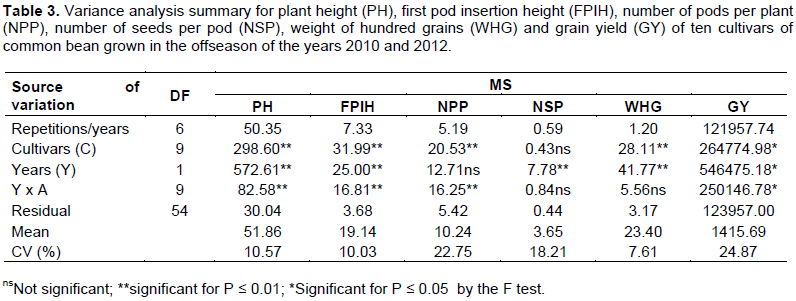
As for plant height (Table 4), for the year 2010 the formation of four statistical groups were observed, being that the cultivars IAC - Carioca Eté and IPR - Tiziu composed the group with the highest average with 67 and 64 cm respectively. While the cultivar IPR Eldorado had the lowest plant height average (41 cm). In the other position during the 2012 dry season, showed a composition of two statistical groups, thus highlighting in the group with the highest mean the IAC - Galante (55 cm) and IAC -Una (55 cm) cultivars.
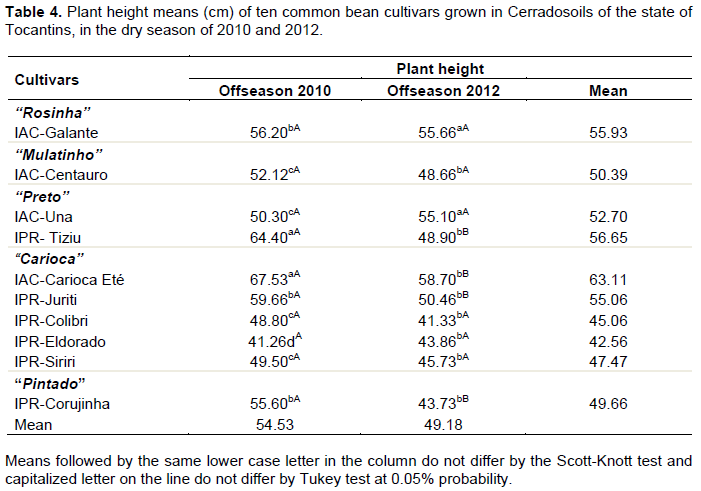
Analyzing the years of cultivation within each cultivar (Table 4) can be observed that most cultivars showed similar plant height between the years of cultivation, although there is a slight reduction in the means of the year 2012. This may have occurred probably because of herbicide application in vegetative stages (V1 - V2) resulted in a phytotoxycity to the bean plants. The cultivars height of IAC - Carioca Eté. IPR - Juriti. IPR – Tiziu and IPR- Corujinha were reduced more sharply becoming a significant difference in plant height in 2012, showing that they were more affected by the action of the herbicide.
The plant height is one characteristic that directly influences the lodging degree, and have to be considered that plants with high stature have a higher occurrence of lodging caused by wind action, however, they cannot be too low because it would turn the mechanized harvesting unfeasible. It was verified that most evaluated cultivars attained the minimum necessary size range for a mechanical harvesting, which according to Simone et al. (1992) should present a minimum height of 50 cm. In relation to the first pod insertion (Table 5), can be perceived the formation of four statistical groups in the offseason of 2010. The highest mean was for the IAC- Carioca Eté with the first pod insertion of 25 cm, while the cultivars IPR- Eldorado and IPR - Juriti presented lower averages for this feature with 16.5 and 14.8 cm, respectively. In 2012, the formation of two groups with results ranging from 20.90 to 16.36 cm was verified. The cultivars IAC - Carioca Eté, IPR-Juriti, IPR- Tiziu, IAC – Galante, IAC -Una and IPR - Siriri comprised the group with the highest height of first pod insertion.
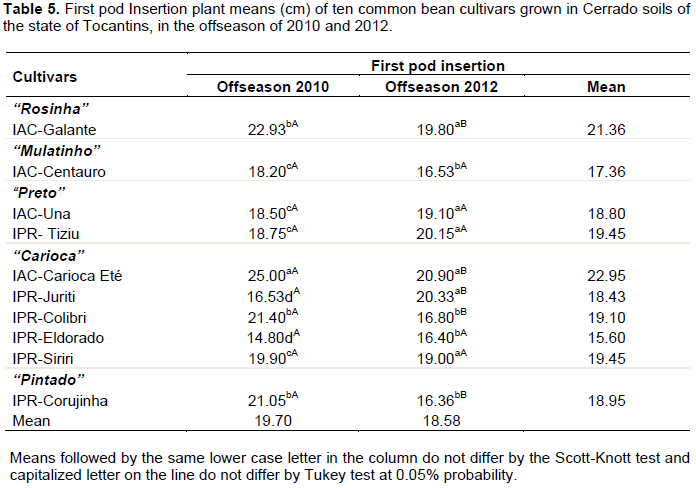
Analyzing the years within each cultivar (Table 5) can be noted that five of the 10 cultivars showed significant differences between the two years (2010 and 2012) of cultivation. These results corroborate those obtained by Zucarelli et al. (2006) which found the height of the first pod ranging from 18.6 to 22.6 cm. According to Souza et
al. (2009), the architecture of the bean plant is a problem, when considering the first pod low height, because this feature prevents the mechanized harvesting.
In Table 6, the data for the number of pods per plant can be observed. In 2010, IPR- Corujinha excelled compared to other cultivars with 15.53 pods per plant. The cultivars IPR- Juriti, IPR- Tiziu, IPR- Siriri, IPR- Colibri, IPR – Eldorado, IAC - Carioca Eté, IAC –Uma, IAC - Centauro and IAC- Galante made ​​up the second group with values ​​ranging from 11 to 7.6 pods per plant, evidencing similar effect for this trait among the various types of commercial grains (Carioca. preto. mulatinho and rosinha). In the offseason crop of 2012 two statistical groups were once again identified, being that the cultivars IPR- Siriri, IPR- Eldorado, IPR- colibri and IPR - corujinha presented higher mean values ​​ranging from 13.55 to 11.73 pods per plant.
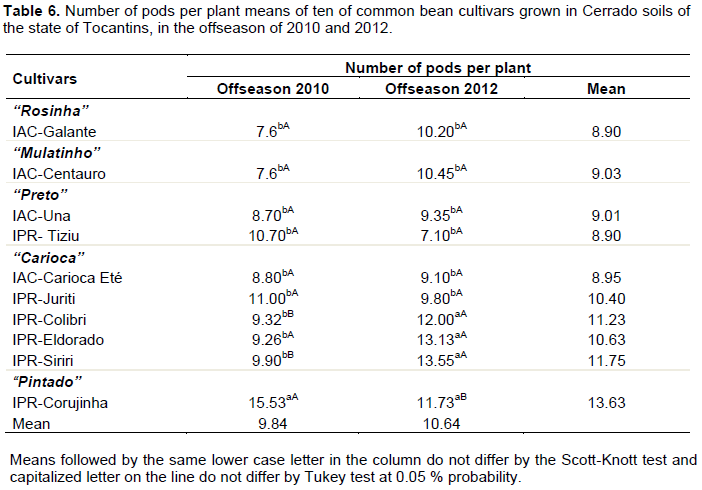
In the statistical unfolding of the years within cultivar (Table 6), there is not significance for most studied cultivars. Zucareli et al. (2006) also observed similar results of that study. Valderrama et al. (2009) evaluating different phosphorus concentrations found number of pods per plant of 9.75 and 9.12 at doses of 100 and 150 kg ha- 1 of P respectively.
The number of seeds per pod showed a mean ranging from 3.99 to 3.23 (Table 7). There was no significant effect among the analyzed cultivars, thus demonstrating that commercial grain types did not affect this feature. It is also observed that plants grown in 2012 had higher number of grains per pod. Analyzing the average of cultivars within years was observed that plants grown in 2012 showed an increase in the number of grains per pod when compared with the 2010 offseason.
Beans crop studies have revealed little variation of the data as the characteristic of the number of grains per pods, and the results of this research confirm those obtained by Lemos et al. (2004) and Zucareli et al. (2006).
The results of the hundred grains mass are displayed in Table 8. There was a formation of four statistical groups. The IAC - Galante got greater mass (27.33 g) and the IAC-Carioca Eté got the lowest mass (20.13 g). The offseason of 2010 resulted in higher grain mass, but with a lower number of seeds per pod.

Superior results were found by Zucareli et al. (2011) whom studying a commercial carioca type cultivar obtained an average of 29 g of mass of hundred grains. According to Ramalho and Abreu (2006), the consumer market prefers carioca´s medium grain types whose size corresponds to the mass of 23 to 25 ​​g per 100 grains. As for grain yield (Table 9), no significant effect was observed in the crops in 2010, and the means ranged from 1861.05 to 1124.31 kg ha-1, outperforming the national average of all cultivars of 895 kg ha-1 (CONAB. 2013). In the cropping year of 2012 can be notice that there was a formation of two statistical groups, with the highest average group consisted of five cultivars (IPR- Eldorado, IAC- Una, IPR-Colibri, IPR-Juriti e IPR-Corujinha with grain yield of 1776, 1580, 1565, 1560 and 1380 kg ha-1, respectively).
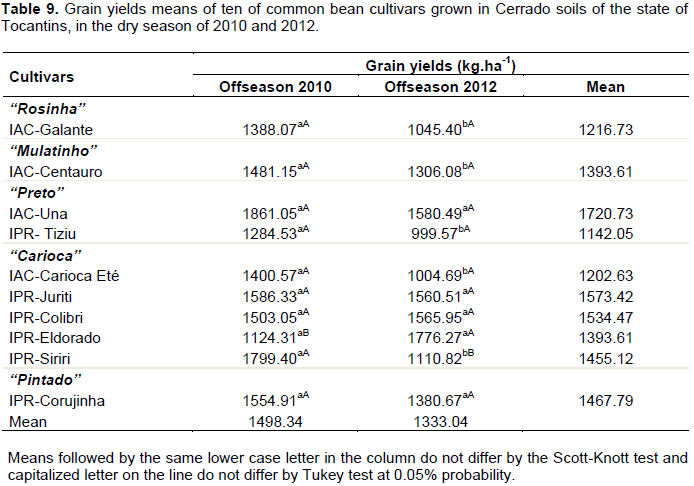
In the statistical unfolding of years of cultivation within each cultivar, there were similarities of grain yield for most cultivars. The IPR - Eldorado cultivar had increase in productivity during the 2012 offseason, while the cultivar IPR-Siriri showed better results in 2010. Superior results were obtained by Valderrama et al. (2009) who achieved 2904 kg ha- 1 of bean´s grain yield. Zucareli et al. (2011) studying the Carioca cultivar at the same P dose in conditions of the state of São Paulo, found similar results for that feature. The results of that research are similar to those obtained by Melo et al. (2004). Carvalho and Wanderley (2007) which evaluating different types of common beans observed grain yield variation comparing the crops of two years, they also found that most cultivars showed no stability in production in different years. Several authors have reported the importance of phosphorus amendment on beans production, evidencing higher grain yields with increases of that nutrient (Fageria and Santos, 1998; Miranda et al., 2000; Silva et al., 2001; Zucareli et al., 2011).
In relation to diseases (Table 10), can be notice that in 2010 the symptoms of anthracnose were found for most cultivars, however, during the 2012 offseason were not detected any symptoms of the disease in the analyzed cultivars. Regarding the rust there was no record of the disease in the two cultivation years, thus demonstrating that the cultivars have potential resistance to the disease. Furthermore, it can be directly associated to climatic conditions, and high temperatures did not favor infection of the pathogen. Evidences that the temperatures oscillated between 11.7 and 39.5°C in the period of the conduction of the experiments.
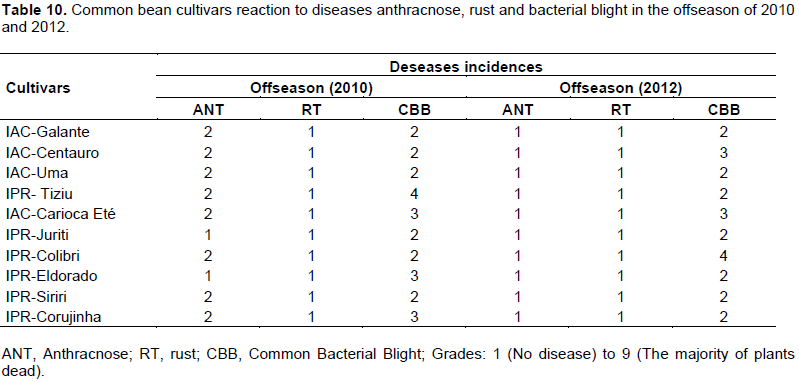
In 2010, all cultivars showed symptoms of common bacterial blight, and the IPR Tiziu had the highest score (4) disease incidence, followed by IAC-Carioca Eté (3), IPR- Eldorado (3) and IPR - Corujinha (3). In the 2012 offseason, similar to what happened in 2010 in all cultivars the disease was detected and the IPR Colibri cultivar had the highest disease severity score of 4. Note that 4 of the 10 studied cultivars showed the same grades in the two years of cultivation for CBB, specifically, IAC - Galante (2) IPR- Siriri (2) IPR- Juriti (2) and IAC - Carioca Eté (3). The assigned scores to cultivars IPR - Juriti and IPR-Eldorado in two cropping years indicates a possible resistance to anthracnose and rust, and those two cultivars belong to the carioca type. It is verified that all cultivars showed some resistance to rust, which might be related to the fact that new cultivars now being launched hold certain resistance to the main diseases of the crop. In all cultivars were detected symptoms of common bacterial blight indicating that the cultivars show susceptibility to the disease. Melo et al. (2007) which also found grades variation between the bean cultivars, identifying symptoms of anthracnose, rust and bacterial blight obtained similar results.
Grain yield of the cultivars IPR-Juriti (carioca) e IPR-Colibri (carioca) remained stable during the two years of cultivation. The IAC -Una and IPR - Siriri cultivars were the most productive in 2010. In the offseason of 2012 the cultivar IPR - Eldorado distinguished among the others. For most cultivars, symptoms of anthracnose and common bacterial blight were detected, however, with a low disease incidence. The cultivars were not infected with rust.